MySQL分类排名和分组TOP N实例详解
表结构
学生表如下:
CREATE TABLE `t_student` ( `id` int NOT NULL AUTO_INCREMENT, `t_id` int DEFAULT NULL COMMENT "学科id", `score` int DEFAULT NULL COMMENT "分数", PRIMARY KEY (`id`) );
数据如下:
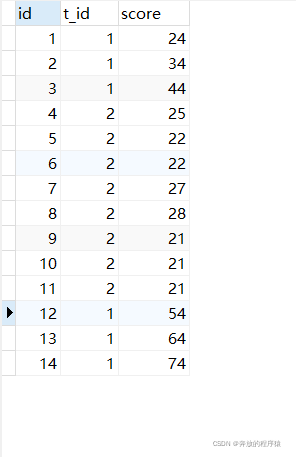
题目一:获取每个科目下前五成绩排名(允许并列)
允许并列情况可能存在如4、5名成绩并列情况,会导致取前4名得出5条数据,取前5名也是5条数据。
SELECT s1.* FROM student s1 LEFT JOIN student s2 ON s1.t_id = s2.t_id AND s1.score < s2.score GROUP BY s1.id HAVING COUNT( s2.id ) < 5 ORDER BY s1.t_id, s1.score DESC
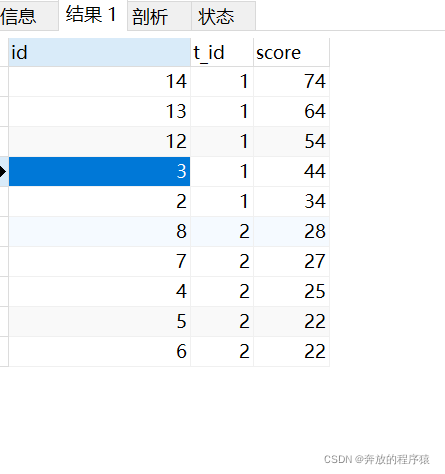
ps:取前4名时
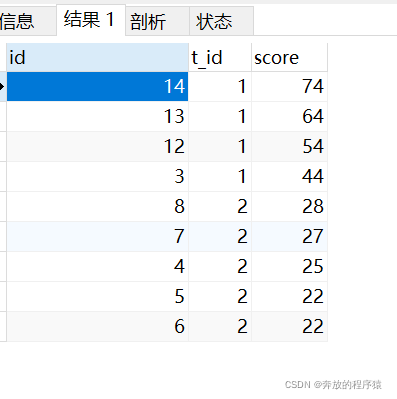
分析:
1.自身左外连接,得到所有的左边值小于右边值的集合。以t_id=1时举例,24有5个成绩大于他的(74、64、54、44、34),是第6名,34只有4个成绩大于他的,是第5名......74没有大于他的,是第一名。
SELECT * FROM student s1 LEFT JOIN student s2 ON s1.t_id = s2.t_id AND s1.score < s2.score
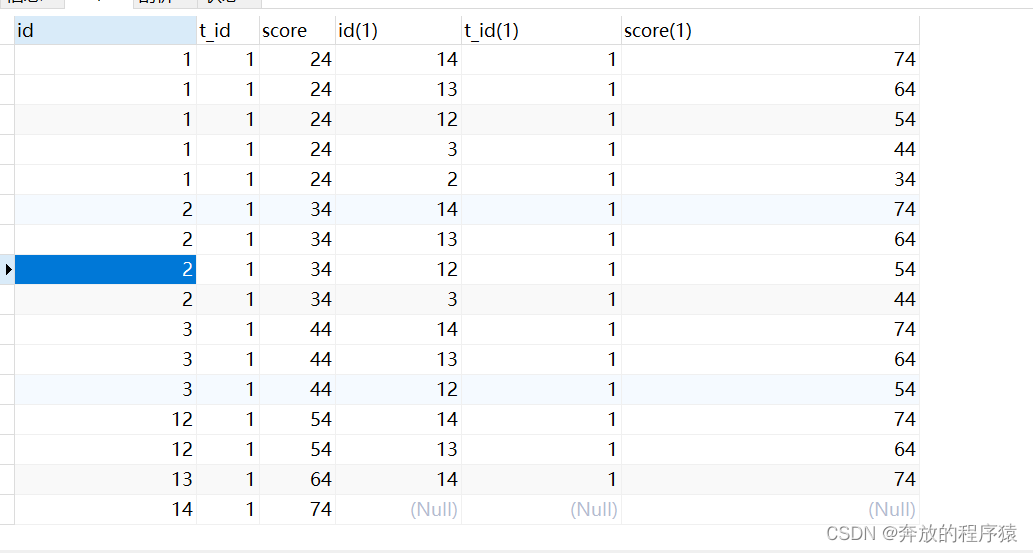
2. 把总结的规律转换成SQL表示出来,就是group by 每个student 的 id(s1.id),Having统计这个id下面有多少个比他大的值(s2.id)
SELECT s1.* FROM student s1 LEFT JOIN student s2 ON s1.t_id = s2.t_id AND s1.score < s2.score GROUP BY s1.id HAVING COUNT( s2.id ) < 5
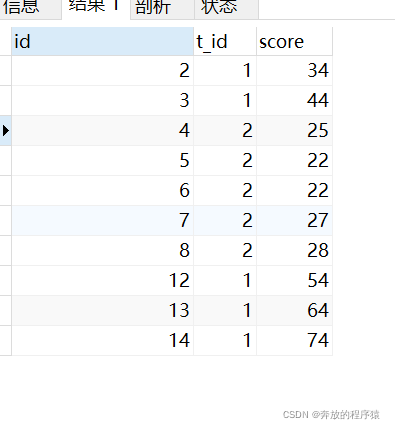
3. 最后根据 t_id 分类,score 倒序排序即可。
题目二:获取每个科目下最后两名学生的成绩平均值
取最后两名成绩
SELECT s1.* FROM student s1 LEFT JOIN student s2 ON s1.t_id = s2.t_id AND s1.score > s2.score GROUP BY s1.id HAVING COUNT( s1.id )< 2 ORDER BY s1.t_id, s1.score
并列存在情况下可能导致筛选出的同一t_id 下结果条数大于2条,但题目要求是取最后两名的平均值,多条平均后还是本身,故不必再对其处理,可以满足题目要求。
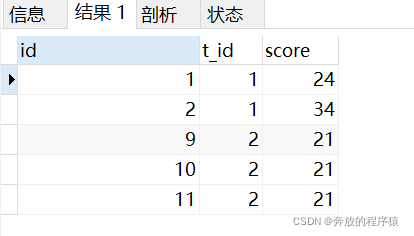
分组求平均值:
SELECT t_id,AVG(score) FROM ( SELECT s1.* FROM student s1 LEFT JOIN student s2 ON s1.t_id = s2.t_id AND s1.score > s2.score GROUP BY s1.id HAVING COUNT( s1.id )< 2 ORDER BY s1.t_id, s1.score ) tt GROUP BY t_id
结果:
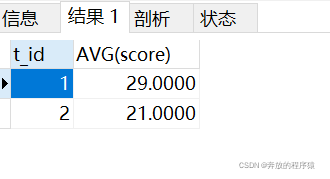
分析:
1. 查询出所有t1.score>t2.score 的记录
SELECT s1.*,s2.* FROM student s1 LEFT JOIN student s2 ON s1.t_id = s2.t_id AND s1.score > s2.score
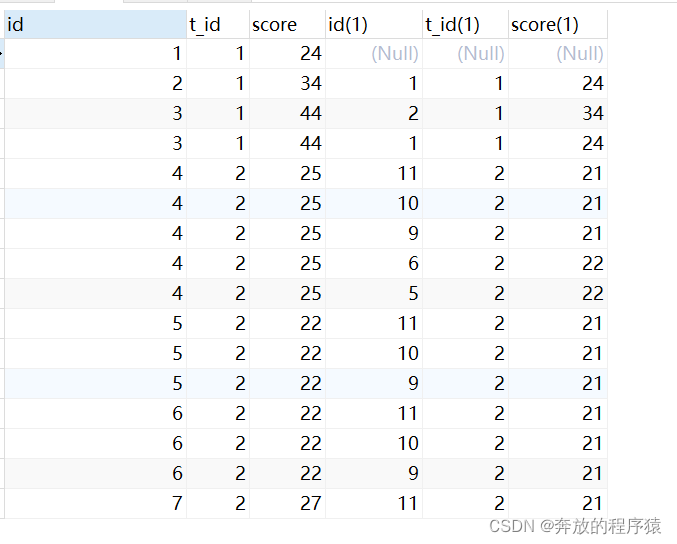
2. group by s.id 去重,having 计数取2条
3. group by t_id 分别取各自学科的然后avg取均值
题目三:获取每个科目下前五成绩排名(不允许并列)
SELECT * FROM ( SELECT s1.*, @rownum := @rownum + 1 AS num_tmp, @incrnum := CASE WHEN @rowtotal = s1.score THEN @incrnum WHEN @rowtotal := s1.score THEN @rownum END AS rownum FROM student s1 LEFT JOIN student s2 ON s1.t_id = s2.t_id AND s1.score > s2.score, ( SELECT @rownum := 0, @rowtotal := NULL, @incrnum := 0 ) AS it GROUP BY s1.id ORDER BY s1.t_id, s1.score DESC ) tt GROUP BY t_id, score, rownum HAVING COUNT( rownum )< 5
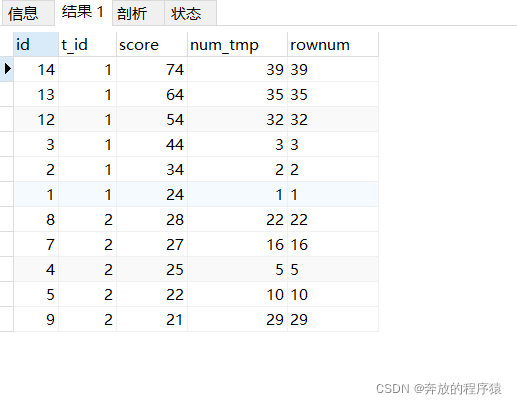
分析:
1.引入辅助参数
SELECT s1.*, @rownum := @rownum + 1 AS num_tmp, @incrnum := CASE WHEN @rowtotal = s1.score THEN @incrnum WHEN @rowtotal := s1.score THEN @rownum END AS rownum FROM student s1 LEFT JOIN student s2 ON s1.t_id = s2.t_id AND s1.score > s2.score, ( SELECT @rownum := 0, @rowtotal := NULL, @incrnum := 0 ) AS it
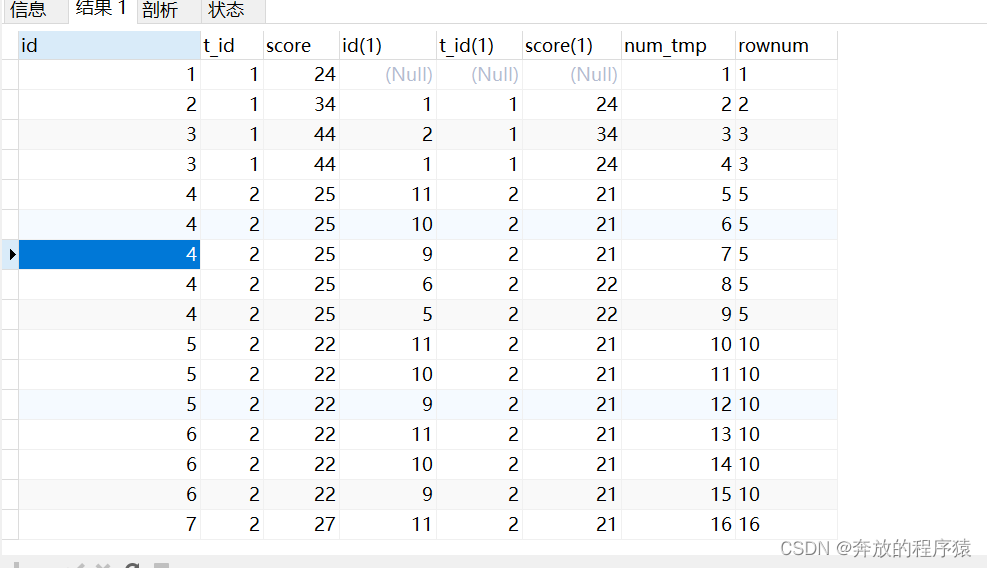
2.去除重复s1.id,分组排序
SELECT s1.*, @rownum := @rownum + 1 AS num_tmp, @incrnum := CASE WHEN @rowtotal = s1.score THEN @incrnum WHEN @rowtotal := s1.score THEN @rownum END AS rownum FROM student s1 LEFT JOIN student s2 ON s1.t_id = s2.t_id AND s1.score > s2.score, ( SELECT @rownum := 0, @rowtotal := NULL, @incrnum := 0 ) AS it GROUP BY s1.id ORDER BY s1.t_id, s1.score DESC
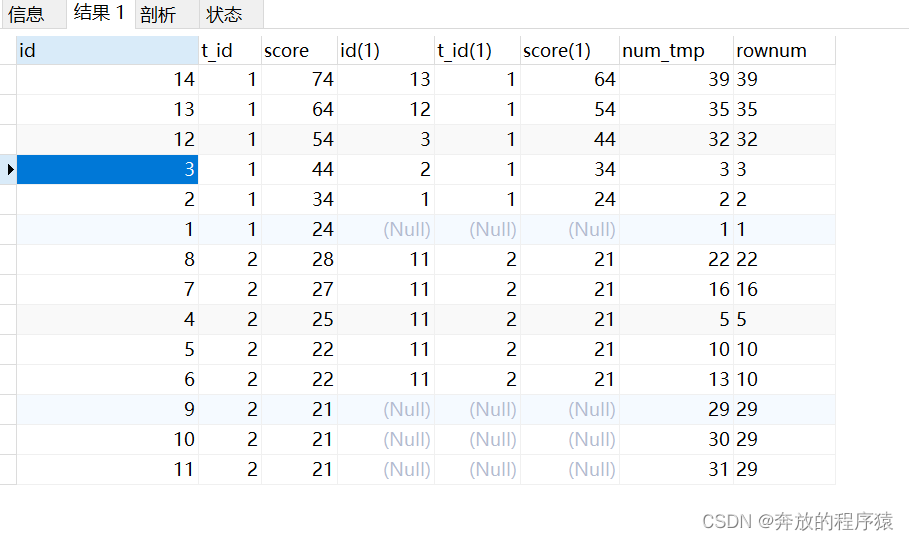
3.GROUP BY t_id, score, rownum 然后 HAVING 取前5条不重复的
总结
到此这篇关于MySQL分类排名和分组TOP N实例详解的文章就介绍到这了,更多相关MySQL分类排名 TOP N内容请搜索服务器之家以前的文章或继续浏览下面的相关文章希望大家以后多多支持服务器之家!
原文链接:https://blog.csdn.net/Dlgdlgd/article/details/122129327
1.本站遵循行业规范,任何转载的稿件都会明确标注作者和来源;2.本站的原创文章,请转载时务必注明文章作者和来源,不尊重原创的行为我们将追究责任;3.作者投稿可能会经我们编辑修改或补充。










